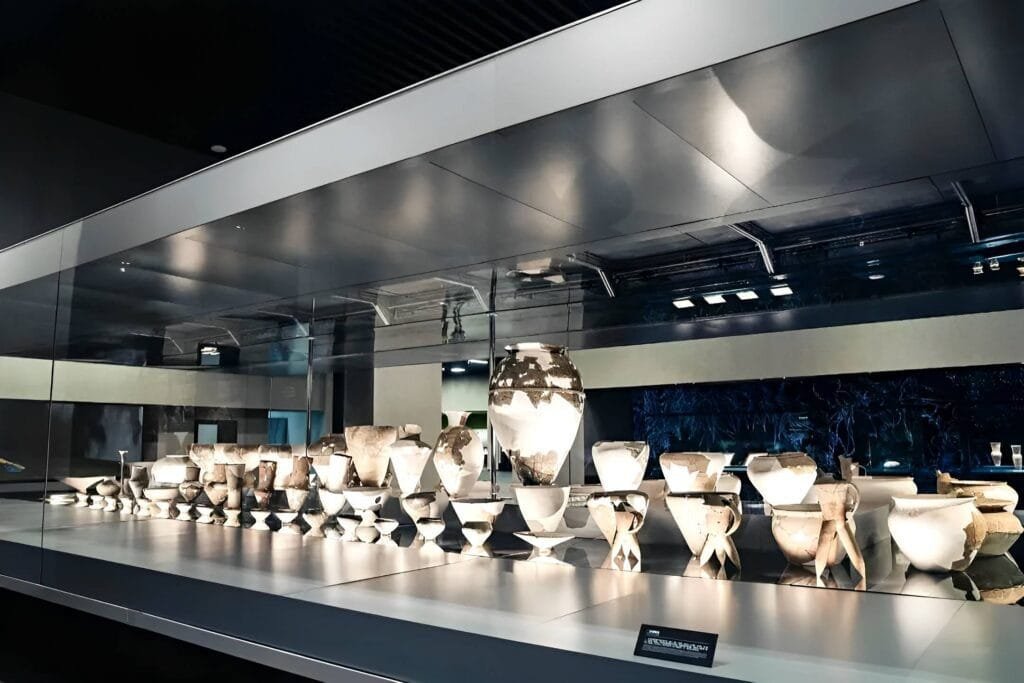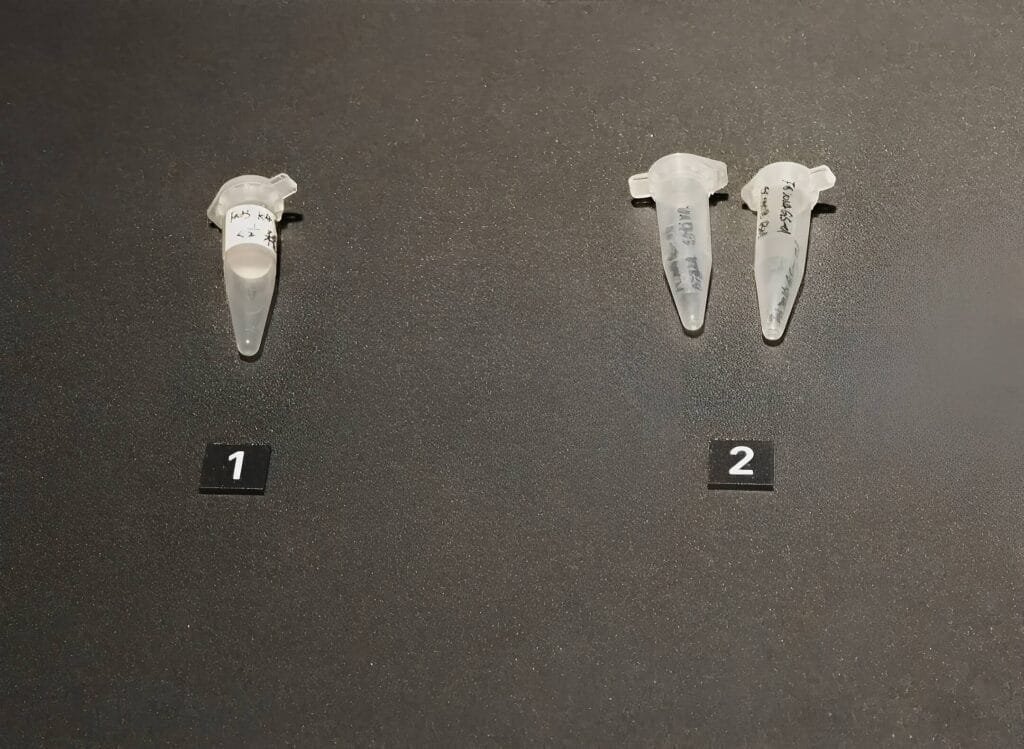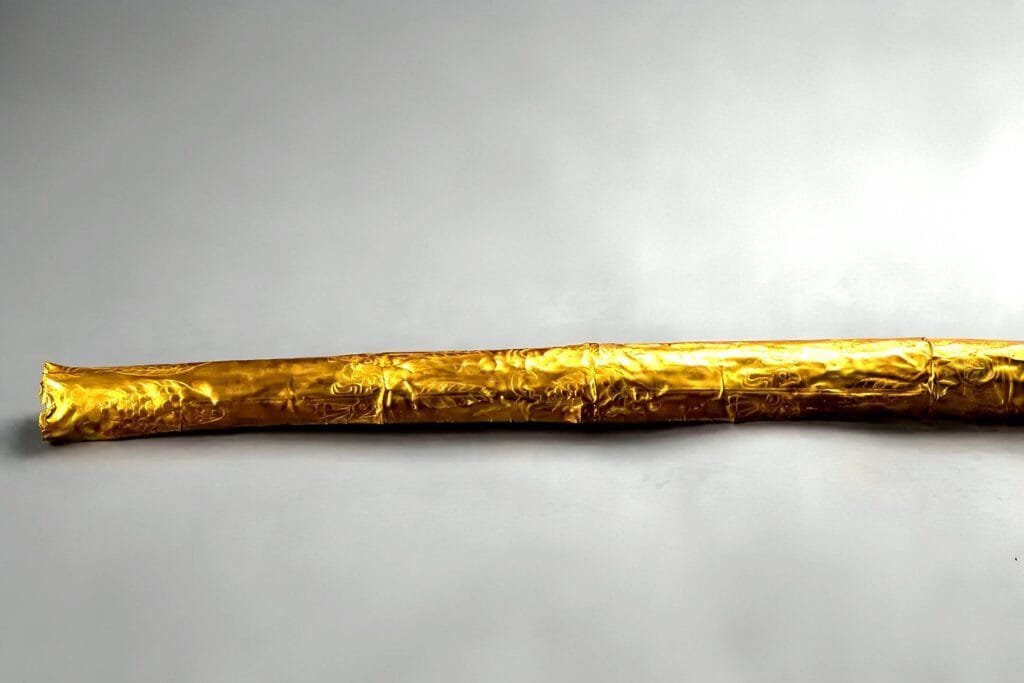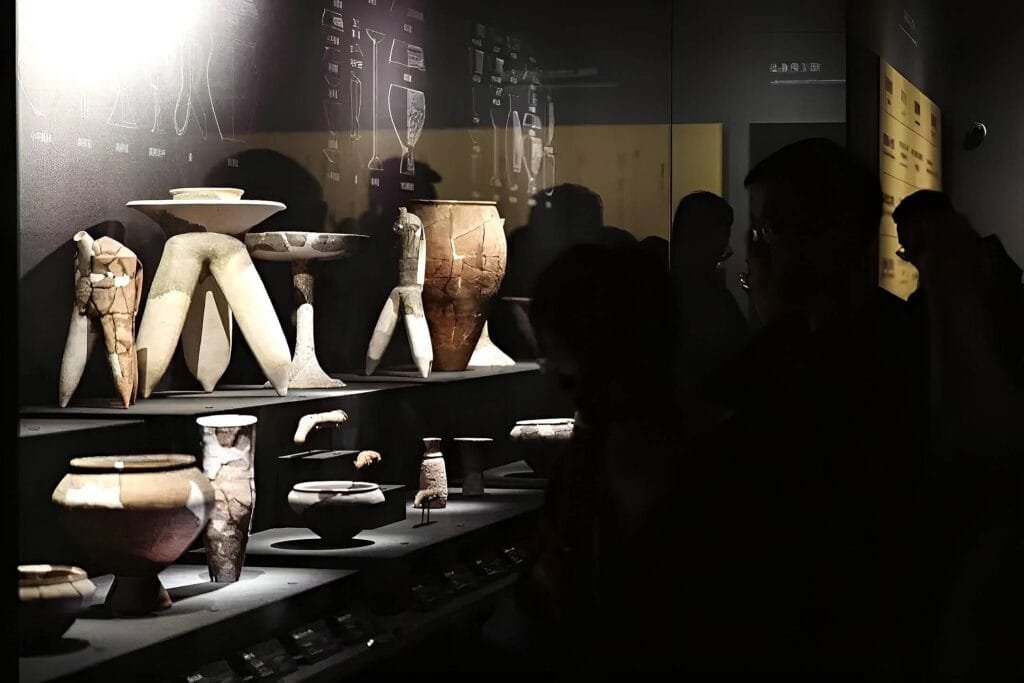When the bronze sacred tree stands still in time, when the gold mask reflects the ancient glory, have you ever wondered how the ancestors of Sanxingdui more than 3,000 years ago cooked a meal in the smoke? In those mysterious archaeological excavation pits, not only are the bright civilization codes buried, but also the fresh eating picture of the ancient Shu people – a feast about “eating” is slowly unveiling. Let’s explore the fireworks and wisdom of life hidden in the depths of the years.

A vast expanse of fertile land,Rice flowers say bumper year
The trace of charred rice quietly tells the staple food code of the ancestors of Sanxingdui. Sanxingdui Site is located in the northern part of Chengdu Plain, with flat terrain and abundant water. In the Annals of Huayang Kingdom and Shu, there is a description of Shu land as “a thousand miles of fertile land.” At present, the traces of rice and millet have been found in the Sanxingdui site through phytoarchaeological methods such as phytoliths study. For example, carbonized rice was found on the Qingguanshan platform in the ancient city of Sanxingdui. It can be said that more than 3,000 years ago, the Sanxingdui culture in Chengdu Plain has entered the life mode based on rice agriculture, and has been able to hold a bowl of fragrant rice, so that rice fragrance infiltrated the four seasons.

The produce is abundant,A meat feast on the banks of the Mamu River
Among the unearthed relics in Sanxingdui Site, there are many lifelike images of livestock and poultry animals, such as charcutery-looking pottery pigs, clever pottery dogs and chickens, as well as beautifully shaped bronze chickens and bronze cows. These cultural relics are shaped in a realistic style, which is completely different from those in Sanxingdui that are shaped in a surreal way. They are like a mirror, which truly reflects the real appearance of domestic animals (birds) in the social background at that time. The ancestors of Sanxingdui were able to create such realistic animal statues precisely because these animals were very common in their daily life and were most likely already included in the meat diet. During this period, the ancestors of Sanxingdui had already mastered relatively mature animal domestication techniques, and had excess food to feed livestock (birds). And these livestock (birds) can also provide Sanxingdui ancestors with meat, eggs, milk and other food supplies.

In the recipes of the ancestors of Sanxingdui, in addition to the meat and fish taste of domestic animals, there may also be a fresh fragrance from the river. The Mamu River, which passes through the city, and the Duck River, which is adjacent to the north, nourish the fishing and hunting genes of the ancestors of Sanxingdui with abundant water systems. Those deeply buried in the sacrificial pits quietly tell the picture of life covered by the bronze light — on the gold staff of the No. 1 pit, the fish and bird patterns are delicate, and an arrow breaks through the air and frames the sharp posture of the arrow cluster. The fish-shaped jade zhang unearthed in the same pit, its jade color changes from green to white with the texture of the fish body, as if holding a live fish frozen for 3,000 years to the eyes.

These cultural relics infiltrated with the spirit of water not only confirm the survival wisdom of the ancient Shu people “relying on water to eat water”, but also let today’s people can glimpse: on the table of the ancestors, in addition to the cooked pork, there may have been a dish of silver scale and dipped in morning dew.
Cook and serve,The smell of fireworks in the pottery
The development of agriculture and livestock breeding in Sanxingdui has gradually increased the types of eating utensils. The “pottery three-legged cookware” unearthed in Sanxingdui in 1986 is very representative, and its function is similar to the “pot” we use for cooking today. It has three pockets of strength, three feet as a support, can be placed in the fire heating. The bag-like foot is hollow, connected with the mouth, and has a wide open upper part, which can hold water or food, and can be considered as a cooking vessel for cooking food. Therefore, some people nicknamed it the “hot pot” of the ancient Shu people. It seems that through this instrument, we can glimpse the lively scene of ancient Shu people sitting together and sharing food.

High handle pottery bean is also one of the typical artifacts of Sanxingdui culture. The upper part is a dish for holding more food, and the middle part is a hollow bean stalk, which is shaped like a tube and communicates with the lower part of the trumpet ring. The highest bean can be nearly one meter. The ancient Shu people sitting on the ground only need to gently reach out their hands, they can easily take the desired food, it not only met the dietary needs of the people at that time, but also by virtue of its unique structure, greatly facilitated the distribution and use of food. Undoubtedly, it is a practical living vessel with a very clever design, which highlights the life wisdom of the ancient Shu people from a subtle point of view.
Jade liquid AGAR,From the mulberry field to the altar of intoxication
“Huayang Kingdom Zhi Shu Zhi” : “The ninth emperor enlightened, began to set up temple, wine said Li, Yue Jing, people are still red, emperor called king.” This shows that in the Kaiming dynasty of the ancient Shu State, there was a phenomenon of wine sacrifice. The history of drinking in the ancient Shu region can be traced back to earlier times. The prosperity of the ancient Shu State wine industry cannot be separated from its unique natural conditions. In the Shang and Zhou Dynasties of the Central Plains civilization, Sanxingdui culture already had mature rice-growing agriculture, and grain surplus was an important prerequisite for the birth of winemaking industry. A large number of pottery wine vessels unearthed in Sanxingdui site, such as gu, bottle, 盉, cup, pot and other types, were unearthed. Among them, the three-foot pottery 盉 can warm the wine by fire, and the bottle-shaped cup arc fits the lips and teeth, and the cup is made of light, confirming the fact that the ancestors of Sanxingdui drank.

In addition, bronze wine vessels were unearthed at Sanxingdui Site, including bronze Zun, 罍 and other ritual vessels, which may be used to hold wine and offer sacrifices to heaven and are endowed with divinity. People offer wine devoutly in the hope of receiving the protection and gifts of the gods. Wine, in the life of Sanxingdui people, may be the joy of the earth in the fields, but also may be the jade liquid on the altar. At this time, a relatively mature brewing industry has appeared in the ancient city of Sanxingdui, and the aroma of wine seems to be constantly circulating between the mulberry field and the altar.

Through the curtain of history, in the hidden corners of Sanxingdui site, we can get a glimpse of the diet style of ancient Shu people thousands of years ago. These precious archaeological discoveries are not only the display of cultural relics information, but also a vivid portrayal of the vivid life of Sanxingdui ancestors, so that we can truly touch the temperature of life in that distant era. In today’s Shu, hot pot is full of red oil, and the wine is mellow and strong, just like a dialogue with the “Ba Shi life” of ancient Shu people. The gene of “delicious” has long been deeply imprinted in the blood of the ancient Shu people, and has become a cultural code across time and space after years of circulation, continuing the unique philosophy of fireworks in this land.
My hometown is three miles away from the ancient Shu ruins of Sanxingdui. I am proud to live in this mysterious land. I would like to share this story with you, please leave a comment. Finally, I would like to recommend the Chinese hot pot in my hometown, Sanxingdui is also the hometown of hot pot:
هات دیگ چینی
هات دیگ یک غذای چینی منحصر به فرد با ویژگی های مختلف و مفاهیم فرهنگی غنی است. قابلمه چینی را بلافاصله می خورند و می پزند و از قابلمه به عنوان ظرف و منبع حرارتی برای گرم کردن قابلمه استفاده می کنند. پس از جوشاندن آب و مواد، غذا آب پز می شود. روش پخت و پز و غذا خوردن همزمان می تواند غذا را گرم نگه دارد و سوپ و مواد را در یک جا نگه دارد.
روش استفاده: همه مواد را در 42.27 اونس آب بریزید و به جوش بیاورید تا طعم رستوران هات دیگ چینی را تجربه کنید.
وزن: 20.28 اونس



